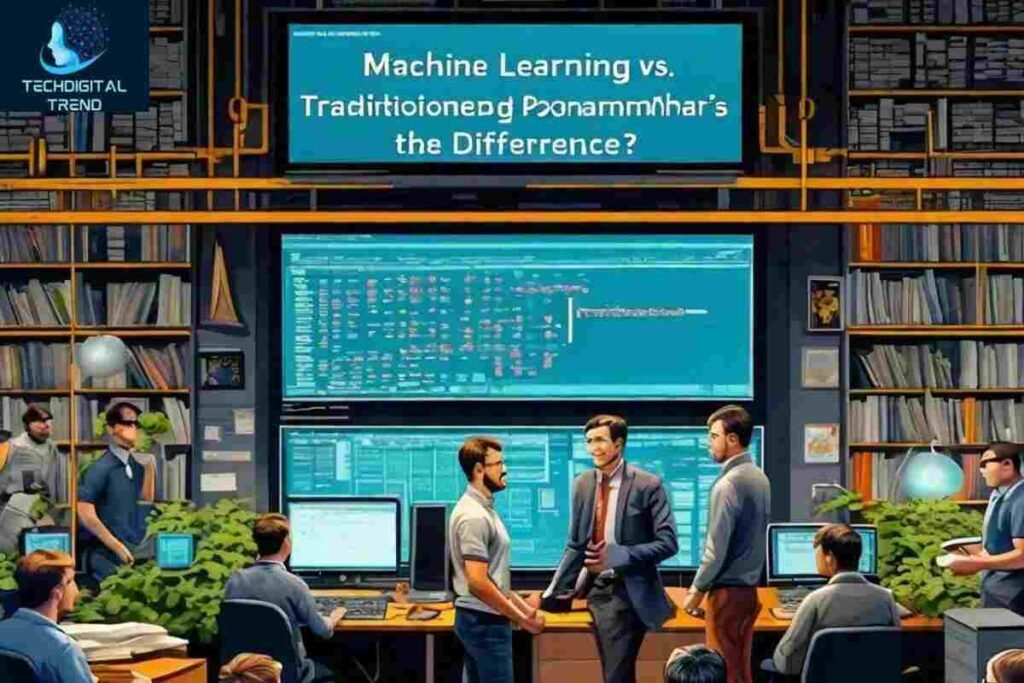Table of Contents
ToggleMachine Learning vs. Traditional Programming
Traditional programming and machine learning are two methods that have completely changed how we create software and tackle challenging issues in the field of computer science. Both are vital tools in a programmer’s toolbox, but their methods, approaches, and applications are very different. We will examine the distinctions between machine learning and conventional programming in this blog article, as well as their distinct qualities, advantages, and applications.
Traditional Programming
Writing precise instructions for a computer to follow in order to carry out a certain activity is known as traditional programming. In order to solve an issue, this method uses logic, algorithms, and predetermined rules. Using a top-down method to divide complicated issues into smaller, more manageable components, programmers develop code in languages like Python, Java, or C++.
Machine Learning
In contrast, machine learning is a branch of artificial intelligence that lets computers pick up knowledge from data without explicit programming. By using massive datasets to train algorithms, this method enables computers to recognize patterns, anticipate outcomes, and gradually enhance their performance. Through the use of a bottom-up methodology, machine learning enables computers to learn from data and adjust to novel circumstances.
Key Differences
- Programming Paradigm: In traditional programming, instructions are given to the computer explicitly by the programmer. This is known as the imperative programming paradigm. In contrast, declarative programming is used in machine learning, where the programmer defines the goal of the computer and an algorithm determines how to accomplish it.
- Problem-Solving Approach: Traditional programming involves breaking down complex problems into smaller parts and solving them sequentially. Machine learning, however, involves training a model on a large dataset and letting it generalize to new, unseen data.
- Data Dependency: Traditional programming relies on a set of predefined rules and algorithms, whereas machine learning relies heavily on high-quality data to train and validate models.
- Scalability: Machine learning can handle large datasets and scale to meet the needs of complex applications, whereas traditional programming can become cumbersome and difficult to maintain as the codebase grows.
- Maintenance: Traditional programming requires explicit updates and maintenance to adapt to changing requirements, whereas machine learning models can adapt to new data and learn from experience.
Real-World Applications
Traditional programming excels in applications that require:
- Predictable outcomes
- Fast execution
- Low latency
- Real-time processing
Examples include:
- Operating systems
- Embedded systems
- Games
- Web applications
Machine learning shines in applications that require:
- Pattern recognition
- Predictive modeling
- Adaptive behavior
- Large-scale data processing
Examples include:
- Image and speech recognition
- Natural language processing
- Recommendation systems
- Fraud detection
- Machine Learning Workflow
The machine learning workflow typically involves:
- Data collection and preprocessing
- Model selection and training
- Model evaluation and validation
- Deployment and maintenance
- Machine Learning Algorithms
Some popular machine learning algorithms include:
- Linear regression
- Decision trees
- Random forests
- Support vector machines (SVMs)
- Neural networks
Conclusion
In summary, there are two unique methods to software development—traditional programming and machine learning—each having advantages and disadvantages. Machine learning works well in applications that need flexibility and pattern recognition, whereas traditional programming is best in those that demand predictability and speed. Programmers may pick the finest tool for the job and create creative solutions that combine the greatest features of both worlds by knowing how these two techniques differ from one another.
FAQs
- Can machine learning replace traditional programming?
No, machine learning and traditional programming are complementary approaches that can coexist and enhance each other.
- Is machine learning only for data scientists?
No, machine learning is a tool that can be used by programmers and developers to build intelligent systems.
- Can traditional programming be used for AI applications?
Yes, traditional programming can be used for AI applications, but it may not be the most efficient or effective approach.
- What is the difference between machine learning and deep learning?
The area of machine learning is more expansive and includes a range of algorithms and methods that allow machines to learn from data. A kind of machine learning called “deep learning” employs multi-layered neural networks to interpret complicated data.
- Can machine learning be used for real-time applications?
Absolutely, real-time applications of machine learning are possible, including recommendation engines, driverless cars, and fraud detection. On the other hand, latency, throughput, and scalability must be carefully taken into account.
Open this link: Tap to here















